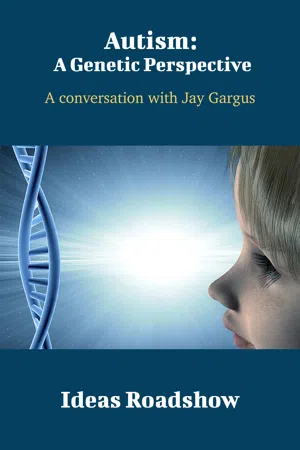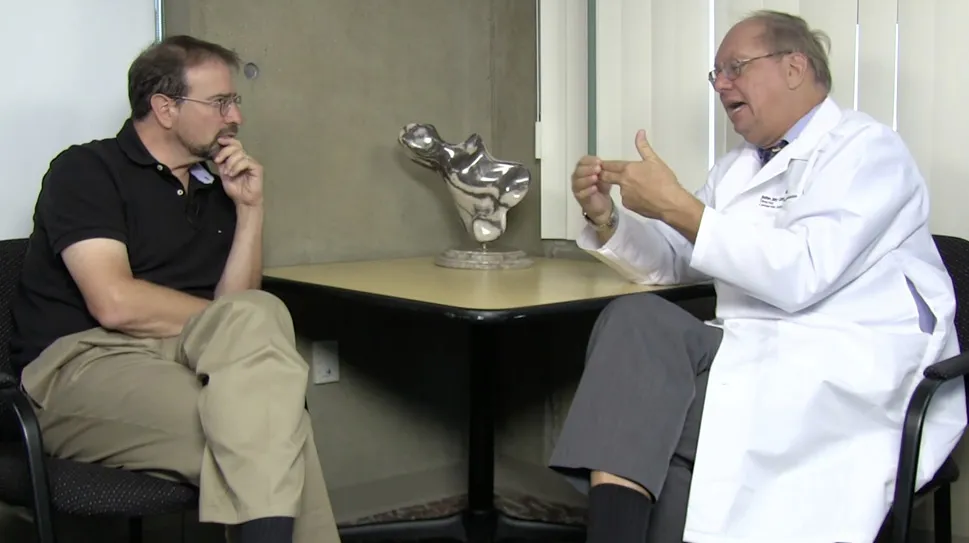![]()
The Conversation
![]()
I. The Lure of Genetics
Where the action was—and still is
HB: You have an MD and PhD from Yale. Were you one of these people who wanted to be a doctor ever since you were a little kid? How did you get into genetics research?
JG: Well, no, it’s certainly not the case that I always wanted to be a doctor. It happened that genetics research was at a very exciting time when I was an undergraduate at Case Western Reserve. They had some very good programs there that let you do research during the month of January—they were called “414” courses.
As a result, I got introduced to some very interesting paradigms that were just evolving in bacterial genetics, and it became very clear to me that that was the way you could answer many complicated problems.
One of my faculty advisers told me, “You know, you really should do an MD-PhD, because this stuff is moving into humans.” I then had the opportunity to go to Cold Spring Harbor Laboratory—Jim Watson had just moved there at that time—and they had training programs for postdocs, but I was able to get into it as an undergraduate, when they were just starting to do genetics in humans.
Then I went to Yale, where they were really doing some pioneering stuff, beginning to do the kinds of genetics in human cells that we knew how to do in bacteria. I was exposed to a lot of pioneering people who were really trying to understand what human mutations were. We didn’t really know, at that time, whether or not human mutations were essentially the same as bacterial mutations: they did a lot of funny things that didn’t exactly correlate with what we expected them to do.
It was a very interesting time; and it’s just been absolutely amazing to see how rapidly human genetics has been transformed. When I was at Cold Spring Harbor, they were passing on the techniques for what we now call “banding” chromosomes, identifying every chromosome separately.
It’s amazing when you think about it: you only have to go back to 1956 to a time when we didn’t even have the right number of chromosomes for humans.
HB: Oh, really?
JG: Yes, we thought there were 48 back then. In 1956, they found out that we really have 46, and it wasn’t until the time around when I was at Cold Spring Harbor that people were able to do banding and recognize each one. They used to be able to recognize them by their size-classes, but with banding they finally became able to actually see each chromosome separately.
Then, while I was at Yale, the first genome was sequenced by Sherman Weissman’s group. It took two floors of the building and about 25 postdocs, and what they sequenced was only 3000 base pairs. It’s the kind of thing that a first-year graduate student can now do in the first day of the first week of her program. It’s really unbelievable how the technology has enormously driven this field over a very short period of time.
So, it’s really been mind-boggling to see that. When I was at Yale as a graduate student, to move a gene, we moved a whole chromosome—and that was considered a major achievement to be able to do that. Now, we can go in and edit every mutation and we can understand all of the sequence.
It’s going to take time to digest all of that information, but it’s all there now.
HB: So, you were at the right place at the right time, it seems—the right place meaning “Planet Earth” essentially. Before I go a bit further, I’d like to return briefly to a throwaway comment you made earlier about how this program at Cold Spring Harbor was usually for postdocs, but you got in as an undergraduate. How did that work?
JG: I’m not sure exactly. I was at Case Western Reserve as an undergraduate, and I had done some interesting undergraduate research there, so they put me into a Master’s program and I got my Master’s degree at the same time as I got my undergraduate degree. One of the faculty at Case Western was going to be teaching at Cold Spring Harbor, and I just got accepted into the program.
HB: OK, so you’re a very self-effacing guy, it seems.
There was something you mentioned in a video of a public lecture of yours that I saw recently, where you explicitly mention how all of us have some genetic susceptibility to diseases that are around us.
We’re going to talk about autism later on, but first, I’d like to talk more generally about this idea of emphasizing the importance of looking at the world through “genetic eyes”, as it were, of being able to get a deeper understanding of how we’re all potentially susceptible to a wide spectrum of different conditions.
JG: Well, everybody’s got the same set of genes—genes are just the names of places on chromosomes—and what we view as the “differences” between people are, in genetics, what we call an “allele”, or a copy: tiny changes in the sequence make for a different DNA sequence and that often makes for a different function—the best understood functional changes are understand in that kind of a manner. The point is (and this has been done for a really long time) that at a mathematical level, we can essentially figure out what the “disease load” is that people typically carry.
I do medical genetics as well, and I often talk to parents whose child has a so-called “recessive” disease, explaining to them the genetics behind it: that each parent is a “carrier”, because both the mom and dad carry abnormal copies and the condition only manifests itself in the child when both abnormal copies are passed on.
As we explain it, we know that everybody carries mutations for probably 7–10 separate lethal conditions, which they’re protected from by the fact that they get a full set of the genome from mom and a full set of the genome from dad. In other words, there’s nothing unusual or “bad” about being a carrier.
In fact, what we really understand is that the best “good” for humans—and all species for that matter—is the breadth of diversity. Your genetic diversity is what lets you get through bottlenecks, through difficult times.
There is no such thing as a “good” genome, it’s just that, under certain circumstances, some convey a certain selective advantage. We see specific examples of this in things like sickle-cell anemia, where if you carry one copy of the sickle-cell anemia gene, you’re protected from things like malaria; but if you get two copies, then you have a serious disease that can be lethal or at least very debilitating.
That’s just one of many examples of a “bad” genome that, in certain circumstances, can be very beneficial.
![]()
- To what extent has our increased understanding of genetics redefined what we mean by “disease”? Readers interested in this topic are referred to Chapter 10 of Our Human Variability with geneticist Stephen Scherer.
- Do you think that technological development in genomics over the next 20 years will be slower, faster or at roughly the same pace as what has happened over the past 20 years?
![]()
II. Genetics 101
A basic overview
HB: Let’s start at the very beginning with some definitions, because if you’re some guy on the street, you’ve probably heard terms like DNA, chromosome, genome or what have you, but it’s useful to start with some tangible specifics.
In particular, at least for me, there’s often a bit of a disconnect between looking at a mutation in general terms as “some structural change to the genetic structure” and the physical mechanisms in terms of the functionality of separate parts that are involved. So it would be helpful to have a bigger picture perspective on all of that.
JG: Well, I’m not going to go back into deep history, but we clearly understand that chromosomes are structures—gigantic strands of DNA—and the “action” part is the DNA part. You can think of DNA as being like “Pop It” beads—a long, linear molecule of letters, where only four letters are used to spell out all the information.
We know that there are only four letter...

